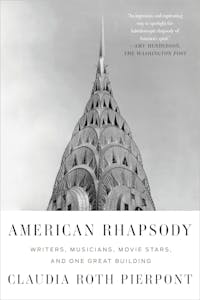American Rhapsody
Writers, Musicians, Movie Stars, and One Great Building
 Download image
Download image
ISBN10: 0374536945
ISBN13: 9780374536947
Trade Paperback
320 Pages
$20.00
CA$23.00
Ranging from the shattered gentility of Edith Wharton's heroines to racial confrontation in the songs of Nina Simone, American Rhapsody presents a kaleidoscopic story of the creation of a culture. Here is a series of deeply involving portraits of American artists and innovators who have helped to shape the country in the modern age.
Claudia Roth Pierpont expertly mixes biography and criticism, history and reportage, to bring these portraits to life and to link them in surprising ways. It isn't far from Wharton's brave new women to F. Scott Fitzgerald's giddy flappers, and on to the big-screen command of Katharine Hepburn and the dangerous dames of Dashiell Hammett's hard-boiled world. The improvisatory jazziness of George Gershwin's Rhapsody in Blue has its counterpart in the great jazz baby of the New York skyline, the Chrysler Building. Questions of an American acting style are traced from Orson Welles to Marlon Brando, while the new American painting emerges in the gallery of Peggy Guggenheim. And we trace the arc of racial progress from Bert Williams's blackface performances to James Baldwin's warning of the fire next time, however slow and bitter and anguished this progress may be.
American Rhapsody offers a history of twentieth-century American invention and genius. It is about the joy and profit of being a heterogeneous people, and the immense difficulty of this human experiment.
Reviews
Praise for American Rhapsody
"[Pierpont] tracks the American spirit in 12 essays that portray individuals who have created the books, songs, films and architecture 'that have become the common air we breathe and that we call a culture.' The result is a compelling group portrait of modern America . . . Her book is an ingenious and captivating way to spotlight the kaleidoscopic rhapsody of America’s spirit."—Amy Henderson, The Washington Post
"This collection of profiles constitutes a fascinating (albeit narrowly focused) little cultural history of America during the last century. Pierpont writes about figures ranging from Edith Wharton to Nina Simone with sensitivity and erudition—and always in dazzling prose. Much of the value of this book lies in Pierpont’s discussion of figures who are little more than names even to well read Americans, or who are completely unknown except to aficionados and academic specialists . . . Pierpont’s gifts as a cultural critic are on full display. Whether she’s writing about the varying quality of James Baldwin’s fiction, Gershwin’s musical influences, or the emotional range of Nina Simone’s singing, her mastery of her material is evident. Pierpont’s subjects are made all the more compelling by her writing. Her account of the world premiere of 'Rhapsody in Blue' made me happy for an afternoon. Her summation of the alcohol-wrecked career of Dashiell Hammett is heartbreaking . . . American Rhapsody is compulsively readable and fascinatingly informative. Learning this much has almost never been so much fun."—Kevin O'Kelly, The Christian Science Monitor
"[Pierpont] applies her sharp mind to dogged journalistic footwork, acquiring and processing a wealth of evidence in the interest of distilling it down. It’s effort well spent, because she consistently tells stories that are dense with information and analysis, while reading like summer page-turners . . . Because she’s so good at what she does, CRP’S profiles in The New Yorker are deeply pleasurable reading, and it’s these profiles that are collected here under the thematic umbrella of an American Rhapsody . . . The book is something of a 'rhapsody' in that its pieces are episodic, yet related, and they do hang together as a broad view of American culture as seen through our canonized art."—Emily Simon, The Buffalo News
Reviews from Goodreads
BOOK EXCERPTS
Read an Excerpt
INTRODUCTION
American Rhapsody was George Gershwin’s original title for the revolutionary work that his brother Ira persuaded him to name, instead, Rhapsody in Blue. Gershwin wanted to call...



